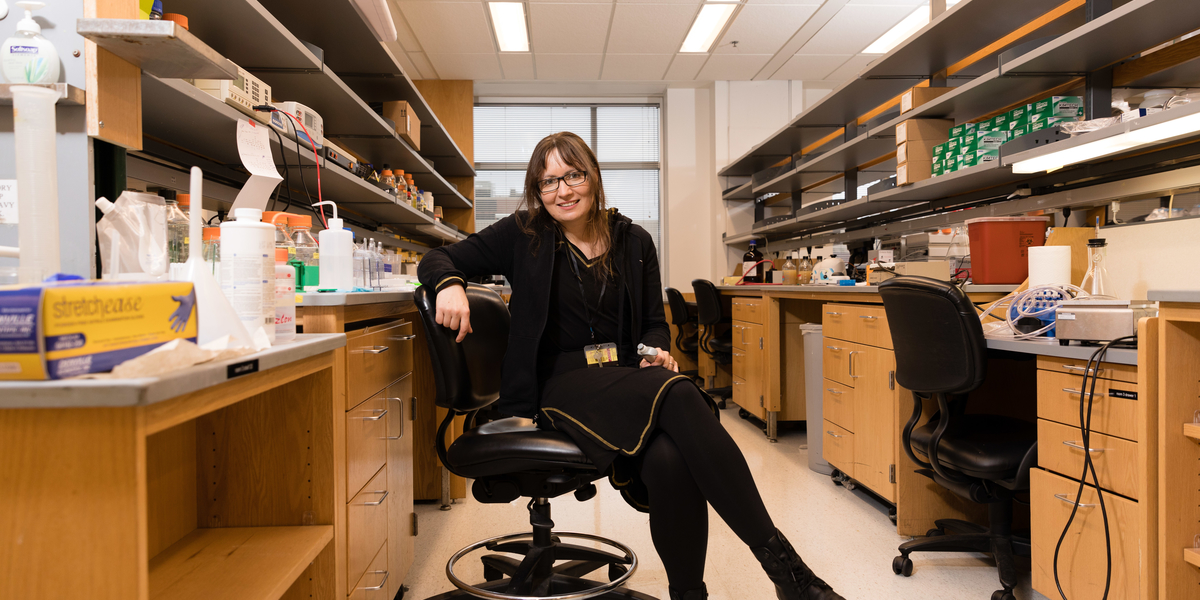
Kate Adamala dreams of a world where people can live with modern comforts without consequence. But given the current state of the planet – climate change, biodiversity loss, microplastics everywhere – the only way she can see that happening is by promoting an economy built on biotechnology. “Right now we have two options,” says Adamala. “We can go back to pre-industrial society or evolve into a sustainable bioeconomy.”
With a bioeconomy, nothing changes for the end user except that the things we like come from sustainable sources. Instead of fossil fuels, harmful mining practices and toxic materials, scientists could program cells to generate biofuels, medicine and biodegradable textiles. The first step is to figure out how to build a cell from scratch.
“Scientists understand a few of the components, like how to engineer DNA and generate new proteins. But critical gaps in knowledge necessary to generate life from non-life remain,” says Adamala. In a new publication for ACS Synthetic Biology, members of the Build-a-Cell network – a community of people working together to build the world’s first human-engineered, “synthetic” cells – recently defined a road map that identifies some of these gaps and challenges as well as hopeful outcomes for the work ahead. It’s the framework for a new field of biotechnology that could change, well, everything.
An economy built on living systems
“Synthetic cells will be capable of doing things natural cells can’t do,” says Kate Adamala, faculty in the College of Biological Sciences and a leader of the Build-a-Cell Network. “Natural cells are burdened by evolution.” Even if you can successfully reprogram a natural cell like E. Coli to generate insulin, it will do it, but only “reluctantly, once all the other processes they rely on to live are satisfied.” Nature has a will of its own.
An ideal synthetic cell is efficient and controllable. Scientists will be their omniscient guides; they’ll determine how the cells will behave and how to keep them contained (a “kill switch” is an imperative part of the process, says Adamala, who notes “we’ve all seen Jurassic Park”) – all because they’ll be the ones who wrote the manual.
The resulting applications are numerous. Scientists could program a de novo cell to generate abundant compounds (pharmaceuticals, biofuels, materials, etc) with fewer resources. They may also be able to create new products altogether – natural cells can generate up to 20 amino acids, but scientists can fabricate up to X by tinkering with their design. Synthetic cells could minimize safety hazards by being easy to contain and control. They could help clean up toxic waste in our environment without the use of extreme heat or chemical additives. In an ideal world, Adamala says synthetic cells could uphold an Earth- and human-friendly “bioeconomy” without changing many of modern society’s unsustainable habits.
But the design of even a simple synthetic cell is still a ways off, perhaps a decade or two, perhaps more.
Life, defined
Members of the international Build-a-Cell consortium share hope that synthetic cells could make life on Earth a better place. But put them in a room and ask them the first and most basic questions about their underlying goal, i.e. “what makes something ‘alive’?”
“Get started on the ‘definition of life’ at these meetings, and you’re done,” says Adamala. “You can be there for a week. But it’s all in good fun.” Defining what makes life, life is as much a philosophical endeavor as it is a biological one. Fire is not alive and yet it multiples. Most scientists agree that viruses aren’t alive either, and yet they have a genome, replicate and respond to their environment.
So how is one to know when they’ve actually done it – when they’ve actually “created” life – or found it, like on a mission to Mars? Perhaps it's impossible to know. Nonetheless, scientists of the Build-a-Cell consortium put their heads together to determine a decisive end goal they could collectively work toward. Ultimately, they determined to build a cell with three essential qualities: compartmentalization (like a membrane or a cell wall), reproduction and metabolism (creating energy from resources). Collectively, a population of cells move, evolve and respond to external stimuli. “We’re sort of cheating by defining life using only what we already know,” says Adamala. But isn’t that all we can do – at least for now?
The final stretch
Of the identified cellular qualities, Adamala says the areas with the biggest scientific gaps are reproduction and compartmentalization. No one has engineered something (from scratch, that is) with the ability to self-replicate or form its own membrane. “That would be a huge deal,” she says.
One victory of modern synthetic biology, however, has been in exploring “cell-free systems,” a sort of experimental method that simulates the chemical environment of a cell using test tubes and a complex mix of nutrients and compounds – sort of like engineered cells without a membrane. Cell-free systems are actually at the core of Adamala’s expertise; understanding and replicating conditions within a cell could point synthetic biologists towards generating a cell with functional components. But a cell with its own containment is more effective than a “cell-free system” – it can survive, in appropriate conditions, on its own with increased resilience.
Adamala is of the mind that focusing energy on this work is the only effective way forward for modern society, but being in the lab everyday keeps her cautiously optimistic. “I’ve seen things fail a lot – everything is possible until proven otherwise. But the current system can't go on. I'm hoping we'll pick evolving forward.” – Adara Taylor